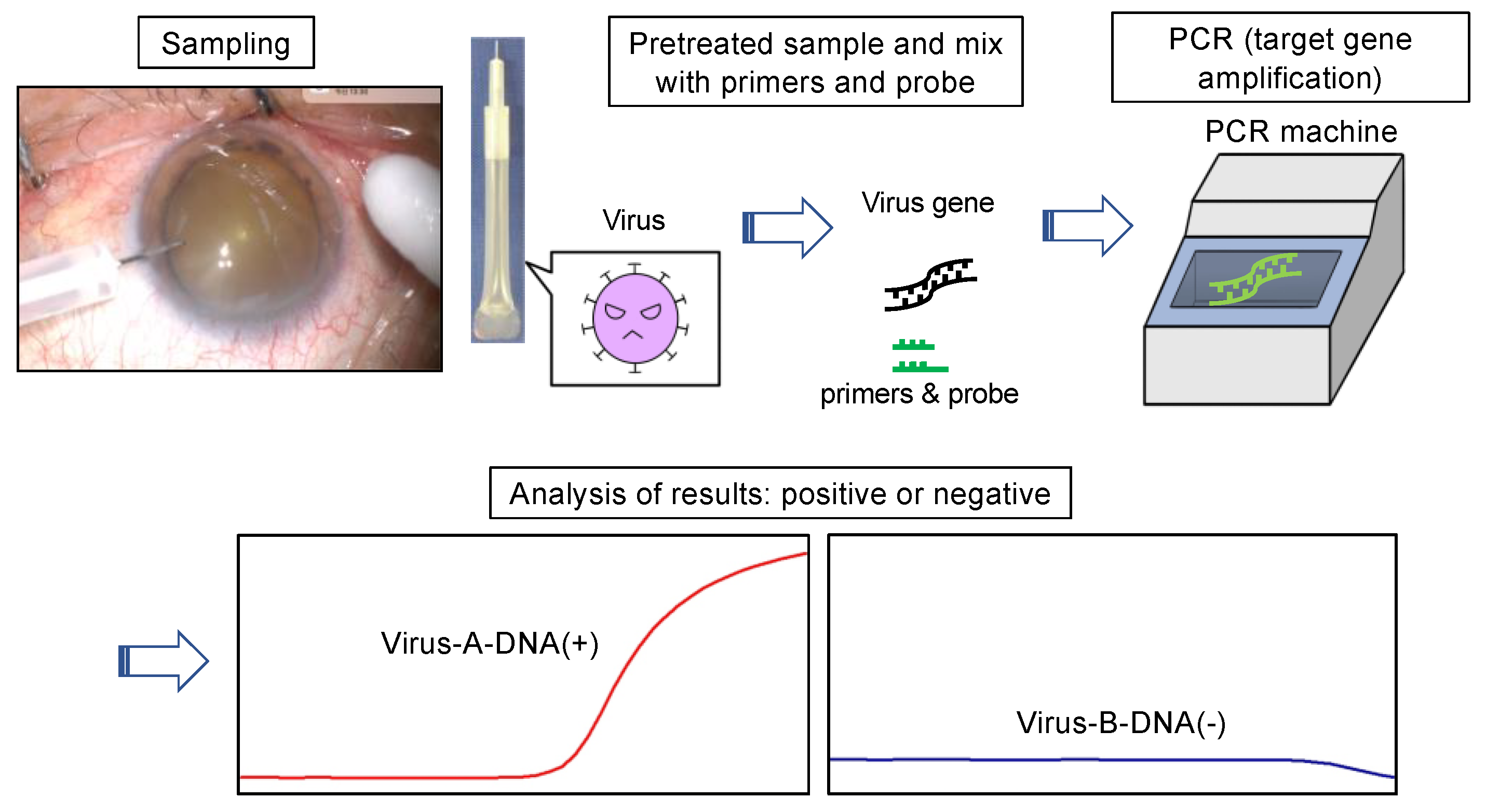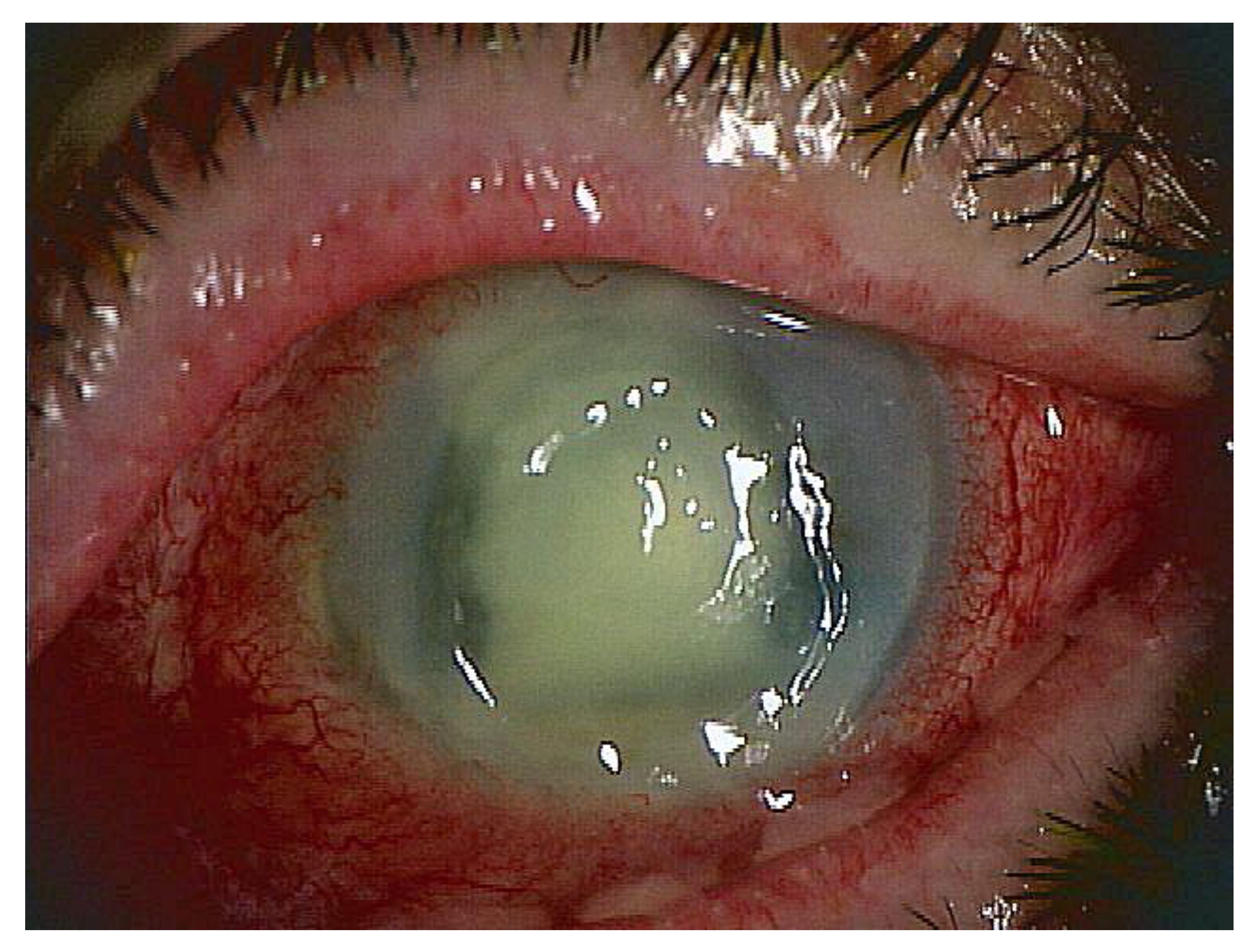Role of Recent PCR Tests for Infectious Ocular Diseases: From Laboratory-Based Studies to the Clinic
Abstract
1. Introduction
2. Characteristics of Ocular Samples, Quality of Samples, and Method of Sample Collection
2.1. Characteristics of Ocular Samples: Specimen Quality
2.2. Method of Sample Collection
2.3. Interpretation and Precautions of PCR Results of Eye Specimen Tests
3. Examination of Multiplex and Broad-Range PCR in Ophthalmology
4. New Findings by Multiplex PCR in the Field of Ophthalmology
5. Recent Molecular Biological Methods for Identifying Infectious Diseases
5.1. Immunochromatography
5.2. Quantitative PCR
5.3. Verigene® and FilmArray®
5.4. nCounter® Analysis System
5.5. Direct Strip PCR®
5.6. Metagenomic High-Throughput Next-Generation Sequencing (mNGS)
6. Conclusions and Future Directions
Supplementary Materials
Author Contributions
Funding
Institutional Review Board Statement
Informed Consent Statement
Data Availability Statement
Conflicts of Interest
References
- Uwamino, Y.; Nagata, M.; Aoki, W.; Fujimori, Y.; Nakagawa, T.; Yokota, H.; Sakai-Tagawa, Y.; Iwatsuki-Horimoto, K.; Shiraki, T.; Uchida, S.; et al. Accuracy and stability of saliva as a sample for reverse transcription PCR detection of SARS-CoV-2. J. Clin. Pathol. 2021, 74, 67–68. [Google Scholar] [CrossRef]
- Sugita, S.; Ogawa, M.; Shimizu, N.; Morio, T.; Ohguro, N.; Nakai, K.; Maruyama, K.; Nagata, K.; Takeda, A.; Usui, Y.; et al. Use of a comprehensive polymerase chain reaction system for diagnosis of ocular infectious diseases. Ophthalmology 2013, 120, 1761–1768. [Google Scholar] [CrossRef]
- Sugita, S.; Takase, H.; Nakano, S. Practical use of multiplex and broad-range PCR in ophthalmology. Jpn. J. Ophthalmol. 2021, 65, 155–168. [Google Scholar] [CrossRef]
- Nakano, S.; Tomaru, Y.; Kubota, T.; Takase, H.; Mochizuki, M.; Shimizu, N.; Sugita, S. Multiplex Solid-Phase Real-Time Polymerase Chain Reaction without DNA Extraction: A Rapid Intraoperative Diagnosis Using Microvolumes. Ophthalmology 2021, 128, 729–739. [Google Scholar] [CrossRef]
- Sugita, S.; Usui, Y.; Watanabe, H.; Panto, L.; Iida, M.; Suginoshita, K.; Koyanagi, K.O.; Nishida, A.; Kurimoto, Y.; Takahashi, M.; et al. Adenovirus-Associated Uveitis with Necrotizing Retinitis. Ophthalmology 2023, 130, 443–445. [Google Scholar] [CrossRef]
- Itoh, N.; Matsumura, N.; Ogi, A.; Nishide, T.; Imai, Y.; Kanai, H.; Ohno, S. High prevalence of herpes simplex virus type 2 in acute retinal necrosis syndrome associated with herpes simplex virus in Japan. Am. J. Ophthalmol. 2000, 129, 404–405. [Google Scholar] [CrossRef]
- Koizumi, N.; Yamasaki, K.; Kawasaki, S.; Sotozono, C.; Inatomi, T.; Mochida, C.; Kinoshita, S. Cytomegalovirus in aqueous humor from an eye with corneal endotheliitis. Am. J. Ophthalmol. 2006, 141, 564–565. [Google Scholar] [CrossRef]
- Kitazawa, K.; Sotozono, C.; Koizumi, N.; Nagata, K.; Inatomi, T.; Sasaki, H.; Kinoshita, S. Safety of anterior chamber paracentesis using a 30-gauge needle integrated with a specially designed disposable pipette. Br. J. Ophthalmol. 2017, 101, 548–550. [Google Scholar] [CrossRef]
- Nakano, S.; Tomaru, Y.; Kubota, T.; Takase, H.; Mochizuki, M.; Shimizu, N.; Sugita, S. Evaluation of a Multiplex Strip PCR Test for Infectious Uveitis: A Prospective Multicenter Study. Am. J. Ophthalmol. 2020, 213, 252–259. [Google Scholar] [CrossRef]
- Nakano, S.; Sugita, S.; Tomaru, Y.; Hono, A.; Nakamuro, T.; Kubota, T.; Takase, H.; Mochizuki, M.; Takahashi, M.; Shimizu, N. Establishment of Multiplex Solid-Phase Strip PCR Test for Detection of 24 Ocular Infectious Disease Pathogens. Investig. Ophthalmol. Vis. Sci. 2017, 58, 1553–1559. [Google Scholar] [CrossRef]
- Kosacki, J.; Boisset, S.; Maurin, M.; Cornut, P.L.; Thuret, G.; Hubanova, R.; Vandenesch, F.; Carricajo, A.; Aptel, F.; Chiquet, C. Specific PCR and Quantitative Real-Time PCR in Ocular Samples from Acute and Delayed-Onset Postoperative Endophthalmitis. Am. J. Ophthalmol. 2020, 212, 34–42. [Google Scholar] [CrossRef] [PubMed]
- Sugita, S.; Shimizu, N.; Watanabe, K.; Katayama, M.; Horie, S.; Ogawa, M.; Takase, H.; Sugamoto, Y.; Mochizuki, M. Diagnosis of bacterial endophthalmitis by broad-range quantitative PCR. Br. J. Ophthalmol. 2011, 95, 345–349. [Google Scholar] [CrossRef] [PubMed]
- Chun, L.Y.; Dahmer, D.J.; Amin, S.V.; Hariprasad, S.M.; Skondra, D. Update on Current Microbiological Techniques for Pathogen Identification in Infectious Endophthalmitis. Int. J. Mol. Sci. 2022, 23, 11883. [Google Scholar] [CrossRef]
- Sugita, S.; Hono, A.; Fujino, S.; Futatsugi, Y.; Yunomae, Y.; Shimizu, N.; Takahashi, M. Detection of Mycoplasma Contamination in Transplanted Retinal Cells by Rapid and Sensitive Polymerase Chain Reaction Test. Int. J. Mol. Sci. 2021, 22, 12555. [Google Scholar] [CrossRef]
- Hariya, T.; Maruyama, K.; Sugita, S.; Takahashi, M.; Yokokura, S.; Sato, K.; Tomaru, Y.; Shimizu, N.; Nakazawa, T. Multiplex polymerase chain reaction for pathogen detection in donor/recipient corneal transplant tissue and donor storage solution. Sci. Rep. 2017, 7, 5973. [Google Scholar] [CrossRef]
- Tan, T.E.; Tan, D.T.H. Cytomegalovirus Corneal Endotheliitis After Descemet Membrane Endothelial Keratoplasty. Cornea 2019, 38, 413–418. [Google Scholar] [CrossRef]
- Sugita, S.; Shimizu, N.; Watanabe, K.; Ogawa, M.; Maruyama, K.; Usui, N.; Mochizuki, M. Virological analysis in patients with human herpes virus 6-associated ocular inflammatory disorders. Investig. Ophthalmol. Vis. Sci. 2012, 53, 4692–4698. [Google Scholar] [CrossRef]
- Onda, M.; Niimi, Y.; Ozawa, K.; Shiraki, I.; Mochizuki, K.; Yamamoto, T.; Sugita, S.; Ishida, K. Human Herpesvirus-6 corneal Endotheliitis after intravitreal injection of Ranibizumab. BMC Ophthalmol. 2019, 19, 19. [Google Scholar] [CrossRef]
- Inoue, T.; Kandori, M.; Takamatsu, F.; Hori, Y.; Maeda, N. Corneal endotheliitis with quantitative polymerase chain reaction positive for human herpesvirus 7. Arch. Ophthalmol. 2010, 128, 502–503. [Google Scholar] [CrossRef]
- Inoue, T.; Takamatsu, F.; Kubota, A.; Hori, Y.; Maeda, N.; Nishida, K. Human herpesvirus 8 in corneal endotheliitis resulting in graft failure after penetrating keratoplasty refractory to allograft rejection therapy. Arch. Ophthalmol. 2011, 129, 1629–1630. [Google Scholar] [CrossRef]
- Sonoda, K.H.; Hasegawa, E.; Namba, K.; Okada, A.A.; Ohguro, N.; Goto, H. Epidemiology of uveitis in Japan: A 2016 retrospective nationwide survey. Jpn. J. Ophthalmol. 2021, 65, 184–190. [Google Scholar] [CrossRef] [PubMed]
- Florkowski, C.; Don-Wauchope, A.; Gimenez, N.; Rodriguez-Capote, K.; Wils, J.; Zemlin, A. Point-of-care testing (POCT) and evidence-based laboratory medicine (EBLM)—Does it leverage any advantage in clinical decision making? Crit. Rev. Clin. Lab. Sci. 2017, 54, 471–494. [Google Scholar] [CrossRef] [PubMed]
- Tsuboi, I.; Iinuma, K. Immunochromatography-Application Example and POCT Type Genetic Testing. Chem. Pharm. Bull. 2021, 69, 984–988. [Google Scholar] [CrossRef] [PubMed]
- De Angelis, G.; Grossi, A.; Menchinelli, G.; Boccia, S.; Sanguinetti, M.; Posteraro, B. Rapid molecular tests for detection of antimicrobial resistance determinants in Gram-negative organisms from positive blood cultures: A systematic review and meta-analysis. Clin. Microbiol. Infect. 2020, 26, 271–280. [Google Scholar] [CrossRef]
- Huang, H.S.; Tsai, C.L.; Chang, J.; Hsu, T.C.; Lin, S.; Lee, C.C. Multiplex PCR system for the rapid diagnosis of respiratory virus infection: Systematic review and meta-analysis. Clin. Microbiol. Infect. 2018, 24, 1055–1063. [Google Scholar] [CrossRef] [PubMed]
- Bispo, P.J.M.; Belanger, N.; Li, A.; Liu, R.; Susarla, G.; Chan, W.; Chodosh, J.; Gilmore, M.S.; Sobrin, L. An All-in-One Highly Multiplexed Diagnostic Assay for Rapid, Sensitive, and Comprehensive Detection of Intraocular Pathogens. Am. J. Ophthalmol. 2023, 250, 82–94. [Google Scholar] [CrossRef] [PubMed]
- Chiu, C.Y.; Miller, S.A. Clinical metagenomics. Nat. Rev. Genet. 2019, 20, 341–355. [Google Scholar] [CrossRef]
- Gallon, P.; Parekh, M.; Ferrari, S.; Fasolo, A.; Ponzin, D.; Borroni, D. Metagenomics in ophthalmology: Hypothesis or real prospective? Biotechnol. Rep. 2019, 23, e00355. [Google Scholar] [CrossRef]
- Low, L.; Nakamichi, K.; Akileswaran, L.; Lee, C.S.; Lee, A.Y.; Moussa, G.; Murray, P.I.; Wallace, G.R.; Van Gelder, R.N.; Rauz, S. Deep Metagenomic Sequencing for Endophthalmitis Pathogen Detection Using a Nanopore Platform. Am. J. Ophthalmol. 2022, 242, 243–251. [Google Scholar] [CrossRef]
- Xi, H.; Zhang, L.; Xu, B.; Liu, H.; Li, S. Metagenomic Next-Generation Sequencing to Investigate Infectious Endophthalmitis of Brucella: A Case Report. Front. Med. 2022, 9, 847143. [Google Scholar] [CrossRef]


| Immune-Chromatography | qPCR | Verigene® (Microarray) | FilmArray® | nCounter® Analysis System | Direct Strip PCR® | mNGS | |
|---|---|---|---|---|---|---|---|
| Sample volume | 100 µL | 100 µL | 350–700 µL | 300 µL | 100 μL | 20 µL | 50 µL |
| Total time | 10 min | 150 min | 150 min | 60 min | 12 h | 60 min | 4 h |
| Pathogens | Limited | Limited | Limited | Limited | Limited | Limited | Comprehensively |
| Sensitivity | Low | High | High | High | High | High | Highest |
| Quantitative | No | Yes | No | No | Yes | Yes | Yes |
| Costs | Low | Middle | Middle | Middle | High | Middle | High |
| Equipment | Nothing | Small, inexpensive | Middle, expensive | Middle, expensive | Expensive | Small, inexpensive | Expensive |
| POCT | Suitable | No | Suitable | Suitable | No | Suitable | No |
| Reference | Need culture 24 h | Skip DNA extraction | Skip DNA extraction |
Disclaimer/Publisher’s Note: The statements, opinions and data contained in all publications are solely those of the individual author(s) and contributor(s) and not of MDPI and/or the editor(s). MDPI and/or the editor(s) disclaim responsibility for any injury to people or property resulting from any ideas, methods, instructions or products referred to in the content. |
© 2023 by the authors. Licensee MDPI, Basel, Switzerland. This article is an open access article distributed under the terms and conditions of the Creative Commons Attribution (CC BY) license (https://creativecommons.org/licenses/by/4.0/).
Share and Cite
Sugita, S.; Takase, H.; Nakano, S. Role of Recent PCR Tests for Infectious Ocular Diseases: From Laboratory-Based Studies to the Clinic. Int. J. Mol. Sci. 2023, 24, 8146. https://doi.org/10.3390/ijms24098146
Sugita S, Takase H, Nakano S. Role of Recent PCR Tests for Infectious Ocular Diseases: From Laboratory-Based Studies to the Clinic. International Journal of Molecular Sciences. 2023; 24(9):8146. https://doi.org/10.3390/ijms24098146
Chicago/Turabian StyleSugita, Sunao, Hiroshi Takase, and Satoko Nakano. 2023. "Role of Recent PCR Tests for Infectious Ocular Diseases: From Laboratory-Based Studies to the Clinic" International Journal of Molecular Sciences 24, no. 9: 8146. https://doi.org/10.3390/ijms24098146
APA StyleSugita, S., Takase, H., & Nakano, S. (2023). Role of Recent PCR Tests for Infectious Ocular Diseases: From Laboratory-Based Studies to the Clinic. International Journal of Molecular Sciences, 24(9), 8146. https://doi.org/10.3390/ijms24098146






